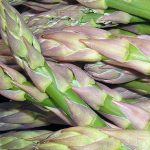
ASPARAGUS
When to Buy/In Season:
March to July, sometimes in fall
How to Select:
Look for: Straight stalks with closed, compact tips, good green color almost entire length (the white area at the end is tough and should be discarded prior to cooking)
Organic Issues:
Commonly found in supermarkets and farmers markets from Spring through Fall, certified organic asparagus is generally the Jersey Knight variety, which is more disease resistant. The standard Washington State strains are susceptible to beetles, spider mites, rust, and fusarium wilt, which conventional farms treat by spraying with pesticides and fungicides.
Pesticide Issues:
EWG 2009 Dirty Dozen, asparagus ranks #42 for highest levels of pesticide residues
How to Store:
Refrigerate in crisper or loose plastic, use within 2 days. Shelf life can be increased by periodically removing moisture that accumulates.
Freezer
To Freeze Fresh Asparagus:
Prepare: Select young tender spears. Wash thoroughly and sort into sizes. Trim stalks and remove scales with a sharp knife. Cut into even lengths to fit containers.
Blanch: Water blanch small spears 2 minutes, medium spears 3 minutes and large spears 4 minutes.
Freeze: Cool promptly, drain and package, leaving no headspace. Seal and freeze.
1 to 1-1/2 pounds yields 1 pintCook from Frozen: 5 to 10 minutes, 1/2 cup lightly salted water for each pint (2 cups) of vegetables
Store: Store frozen asparagus in the freezer (0F) for up to 6 months
Canning
Store commercially canned asparagus, unopened, at room temp up to 12 months
Photo Sources: Andrewhallpics
Return to Buying and Storage Guides


